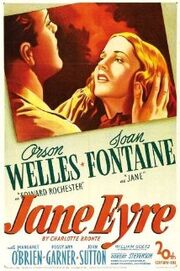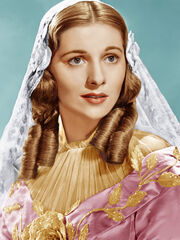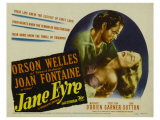
Introduction[]
Jane Eyre is an American film adaptation of Charlotte Brontë's 1847 novel of the same name, released by 20th Century Fox on Christmas Eve 1943. Directed by Robert Stevenson, the film stars Orson Welles and Joan Fontaine as the leading characters of Rochester and Jane, with Elizabeth Taylor making a short appearance as Helen. The viewers are reminded time and time again that this film is a gothic story by the use of dark clouds, fog, and gothic architecture throughout, in addition to a very dramatic soundtrack that confirms the mystery and suspense of this narrative. The movie begins at the Reed home where Jane lives with her aunt and male cousin, but the narrative quickly moves to Lowood School, skipping over the incident in the Red Room which figures prominently in Brontë's book. The basic storyline remains similar to the source text until Jane leaves Thornfield after discovering that Rochester is in fact a married man. Her time away from Thornfield is covered in less than ten minutes of the film, and during this section Jane journeys back to her Aunt Reed’s house rather than seeking out into the unknown world as she does in the source text. She does not meet her before unknown Rivers cousins nor lives in their home Moor House nor does she receive a marriage proposal from Mr. Rivers.
Distinctive features[]
The film is opened by a narrator reading a page displayed on the screen, ostentatiously taken from Chapter 1 of the source text, providing a general introduction to the plot and characters for the viewers – except that the narrator is not reading from the original novel’s first chapter at all. By using printed pages from the book throughout - the other passages being true excerpts from Brontë's text except for that initial scene - the director seeks to establish the film’s reliance on the original text for its source. The most notable alteration in this adaptation is the deletion of the sizeable section of the narrative set in Moor House with Diana, Mary, and St. John Rivers. This omission puts the love story between Jane and Mr. Rochester front and center in the plot line.
Historical time frame[]
The screenplay for this movie was written and revised multiple times between 1940 and 1943, a time period when women’s lives were drastically changing due to the American involvement in the Second World War. The war increased the demand for women to enter the work force, and after the attack on Pearl Harbor the work force increased by 6.5 million women. By the time this movie was released, thirty-seven percent of all American women were in the work force, many in well-paying unionized jobs such as in munitions plants and aircraft industries (Brosh 48). In late 1943, when Jane Eyre began to show in theaters, there were rumors that the war would be over soon, which led to a systematic campaign to encourage women to return home to their children, leaving their jobs, especially the better-paying unionized jobs, for the men returning from war. This film adaptation tried to dissipate anxieties about women leaving their maternal domestic roles and helped construct a more traditional depiction of motherhood that would have been in line with the leaders in business and government who were advocating women to return to the home after the war.
Feminism[]

Joan Fontaine in Jane Eyre. She also played the vulnerable heroine in Rebecca (1940) and Serenade (1956).
The importance of a strong female character is downplayed in this adaptation. Though Jane remains resolute in the face of the harsh treatment at Lowood, overall she is demure and reserved in this movie. The novel by Charlotte Brontë was known by many as “the first feminist novel” (Bowen qtd. in Brosh 45) and seen as a feminist manifesto by some literary critics. However, this film has little of the heated speeches and fiery personality of Jane present in the original narrative. In addition, the strength of Jane’s sexuality and desire present in Brontë's novel is watered down in this film version, instead “redefining the terms of sexual desire, by rooting female sexuality in maternal bonds” (Brosh 57).
Instead of the ambiguous and somewhat troubling ending found in Brontë's novel, Stevenson’s adaptation ends with a simple tableau of Jane and Rochester happily married with a young son. This “happy ending” helps reinforce a stable feminine ideal and asserts the significance of marriage, home, and motherhood, especially critical as the Second World War was drawing to a close (Brosh 64).
'M'otherhood[]
In Charlotte Brontë’s novel, the absence of a mother or any decent mother figures liberates Jane and helps to reconfigure gender identities in a manner radically different from the ideal of Victorian English society (Dever 31). However, ideal womanhood is portrayed in this adaptation as maternal and home centered, which stems from the social concerns of the time as the Second World War was almost over. This fundamental change to the plot is shown in several ways throughout the movie. The film changes two of the novel’s characters, Mrs. Reed and Bessie, so they can epitomize the ideal mother (Bessie) and its antithesis (Mrs. Reed). Both Helen and Adele, whose actresses incidentally look very similar, are characters used in this film to represent a feminine influence that will ultimately liberate Jane: Helen tries to free Jane from Brocklehurst’s “jail” in Lowood and Adele frees Jane from her mental imprisonment. Jane’s happiness is linked not only with romance (with Rochester) but to the bonding of a child (Adele) as well. This is a divergence from the novel that makes the mother/daughter bond central to Jane’s development (Brosh 53-55).
Masculinity[]
Orson Welles plays a very strong Byronic Rochester character – tall, dark, broad chested, and gruff in all his manners. The character of Rochester in Brontë's novel also has all these same features, but this adaptation seems to emphasize them to the extreme, thus giving him more power in the relationship dynamic with Jane. The fantasy of masculine dominance and female submission might have been popular for the audience of 1940’s America but was a drastic departure from the original 1847 narrative by Brontë.
Reception and Further Adaptations[]
Despite critical acclaim, the film barely broke even and failed to gain a wider audience largely because of the competitive market (coming right after romance blockbusters Gone with the Wind and Rebecca ) and because it was marketed as a gothic romance (Sadoff 79). The 1970 Delbert Mann Jane Eyre film is very different from this 1943 adaptation, instead emphasizing the egalitarian aspects of Jane and Rochester's relationship, especially in their dialogue. The 1970 adaptation is also more attentive to the beginnings of the women's movement. There have been many other subsequent adaptations , including films, plays, television programs, and musicals as well as a graphic novel.
Works Cited[]
Brosh, Liora. Screening Novel Women: From British Domestic Fiction to Film. New York: Palgrave Macmillan, 2008. Print.
Dever, Carolyn. Death and the Mother from Dickens to Freud: Victorian Fiction and the Anxiety of Origins. New York: Cambridge University Press, 1998. Print.
Sadoff, Dianne F. Victorian Vogue: British Novels on Screen. Minneapolis: University of Minnesota Press, 2010. Print.



